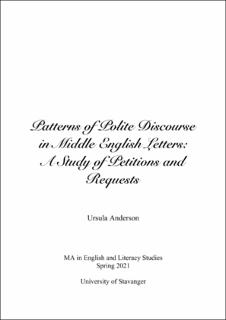| dc.description.abstract | The thesis is a study of nineteen late medieval letters of petition and request from the Corpus of Middle English Local Documents (Stenroos, Thengs and Bergstrøm 2017-) based on politeness theory and speech act theory. The letters are from the fifteenth century and were written by men and women from different social backgrounds and addressed to the prior of Durham or other authorities. The study deals with the politeness strategies men and women from different social classes used to formulate their requests.
The study is based on two assumptions: that patterns of polite speech varied according to social class and gender, and that there exist specific formal characteristics that distinguish a petition from a request. Thus, this thesis sets out to investigate two research questions: 1) to what extent do gender and hierarchical interrelationships determine the choice of polite and direct language in petitions and requests, 2) to what extent do the formal characteristics of the letters reflect the subcategories “petitions” and “requests”?
Because of its historical distance, this thesis takes a historical pragmatic approach. First, this thesis considers the socio-historical context in which these letters were produced and provides an overview of the social order, literacy levels, the letter-writing practices, and the genre expectations. Second, it considers two theories as the groundwork for this study: politeness theory and Speech Act theory.
As the study is qualitative and based on a limited corpus, it does not to produce overall generalisations; however, it offers some interesting results. There seems to be manifestations of politeness strategies that varied according to social class in terms of the first assumption. The nobility used positive politeness strategies frequently, employing ‘promises of future help’ and ‘expressions of trust’ as supporting moves towards their requests. Social class also turns out to play a role in terms of the choice of speech acts. While the nobility preferred the performative directive pray, other classes employed the performative beseech. In terms of the second assumption, this thesis concludes that the formal characteristic of a particular group of letters of petition might have implications for the function and, thus, categorisation of the letters in the Corpus of Middle English Local Documents.
This thesis contributes to the research area of historical pragmatics, more specifically to the research concerning Late Medieval correspondence. | |
